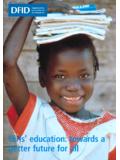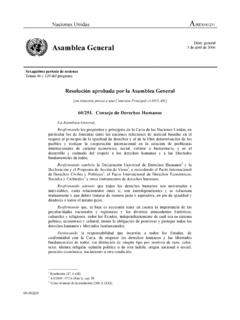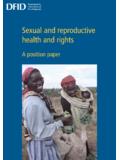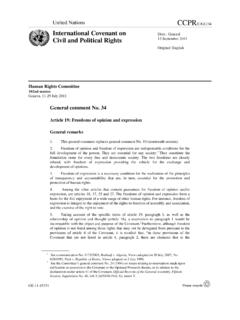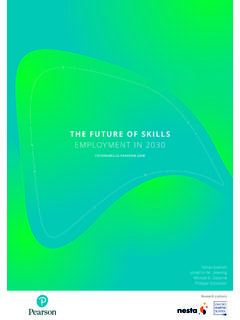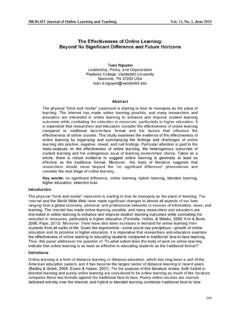Transcription of Girls’ education: towards a better future for all
1 Girls education : towards abetter future for allCover photo: A schoolgirl in Surinam. ( Ron Giling/Still Pictures)Girls education : towardsa better future for allPublished by the Department for International DevelopmentJanuary 2005iiby the Secretary of State for International Development To be educated I will not only be able to help myself, but also my family,my country, my people. The benefits will be many. MEDA WAGTOLE, SCHOOLGIRL, ETHIOPIAAt the turn of the millennium, the international community promised that by 2005, there would beas many girls as boys in school. Later this year, when leaders from around the world come togetherto take stock of the Millennium Development Goals, there will be no escaping the fact that we havecollectively failed to keep this promise.
2 Despite much progress, a child without an education is stillmuch more likely to be a girl than a strategy is a first step to get us back on track. It acknowledges that we all need to dosubstantially more to help girls get into school. It reminds us of the value of education for liftingnations out of instability and providing a more promising future to their people. And regardless ofwhether they live in a wealthy or poor country, nothing has as much impact on a child s future well-being as their mother s level of do not need complex international negotiations to help solve the problem of education . We justneed to listen to governments, local communities, children, parents and teachers who know whatchallenges remain. And we need to provide them with enough funding to put their ideas oneducation into this end, we plan to spend at least billion over the next three years.
3 This money will provideadditional support to governments and more resources to strengthen international efforts to co-ordinate action on girls example set by countries like Malawi, where the Minister for education announced freeschooling and immediately increased enrolment rates, shows just what can be achieved when thereis a clearly defined plan of action and enough political will to implement 2005, the UK will hold the Presidencies of the G8 and the EU. We will use our leadership role tomake achieving gender parity in education a priority for the international Meda Wagtole s words make clear, keeping our promise on girls education will not just give girlsbetter prospects; it holds the key to giving their families, communities and countries a better futureas Hon Hilary Benn, MPivGirls education : towards a better future for matters2 education is a right but it is still beyond the reach of many3A timely prevents girls from getting a quality education ?
4 6 Educating girls is costly for families7 Girls may face a poor and hostile school environment9 Women have a weak position in society10 Conflict hurts girls most11 Tackling social girls education on the ground12 Political leadership and empowerment of women matter12 Making girls education affordable15 Making schools work for all girls17 Charities, religious and other voluntary organisations are good for girls18 Supporting policies that international efforts on girls education21 More resources are needed21 Donor actions in support of country-led development22 International organisations need to work together for girls education23 Civil society s role in building global momentum and local a better future for all27 Annexes29 Endnotes33vContentsviThere are still 58 million girls worldwide who are not in school.
5 The majority of these girls live in sub-Saharan Africa and South and West Asia. A girl growing up in a poor family in sub-Saharan Africa hasless than a one-in-four chance of getting a secondary education . The Millennium Development Goal(MDG) to get as many girls as boys into primary and secondary school by 2005 is likely to be missedin more than 75 need to make much better progress. There is growing international commitment and consensuson what can be done to improve girls education . This strategy sets out the action DFID will take andthe leadership we will provide, with others in the international community, to ensure equality ofeducation between men and women, boys and girls. We will work to narrow the financing gap for education . Over the next three years, DFID plansto spend more than billion of aid on education .
6 We will work with the United Nations Children s Fund (UNICEF) to strengthen its capacity toco-ordinate action on girls education . We will use the UK s Presidencies of the G8 and EU and our role as co-chair of the Fast-TrackInitiative (FTI) to push gender equality in education up the political agenda. We will support the efforts of governments in developing countries to produce plans thatprioritise girls education . This will include providing financial help to those wanting to removeschool fees. We will work with our development partners to increase educational opportunities for girls;civil society will be a key partner in this work. We will increase our efforts to promote awareness within the UK of girls education inpoor girls helps to make communities and societies healthier, wealthier and safer, and can alsohelp to reduce child deaths, improve maternal health and tackle the spread of HIV and AIDS.
7 Itunderpins the achievement of all the other MDGs. That is why the target date was set as 2005. Thatis also why in 2000, at the Dakar Conference, donors promised that every country with a soundeducation plan would get the resources it needed to implement has been hampered by a number of factors: a lack of international political leadership, aglobal funding gap of an estimated $ billion a year for education , a lack of plans and capacitywithin national education systems to improve the access to and quality of schooling for girls, andlocally many poor families who simply cannot afford to send their children to paper marks a new phase in the UK s support to girls is the time to mattersIn September 2000, 188 heads of state from around the world signed the Millennium Declarationand established the Millennium Development Goals (MDGs).
8 While most goals aim to achievesignificant progress in development by 2015, one goal was to be achieved by 2005 gender parityin primary and secondary education . But, more than 75 countries are likely to miss this goal. We arefalling well short of our are at the heart of most societies. Regardless of whether they are working or not, mothers arevery influential people in children s lives. Educating girls is one of the most important investmentsthat any country can make in its own has a profound effect on girls and women s ability to claim other rights and achievestatus in society, such as economic independence and political representation. As the followingexamples demonstrate, having an education can make an enormous difference to a woman schances of finding well-paid work, raising a healthy family and preventing the spread of diseasessuch as HIV and AIDS.
9 Women with at least a basic education are much lesslikely to be poor. Providing girls with one extra year ofschooling beyond the average can boost their eventualwages by 10 to 20 per An infant born to an educated woman is much morelikely to survive until adulthood. In Africa, children ofmothers who receive five years of primary educationare 40 per cent more likely to live beyond age An educated woman is 50 per cent more likely to haveher children immunised against childhood If we had reached the gender parity goal by 2005,more than 1 million childhood deaths could have For every boy newly infected with HIV in Africa, there are between three and six girls newlyinfected. Yet, in high-prevalence areas such as Swaziland, two-thirds of teenage girls in schoolare free from HIV, while two-thirds of out-of-school girls are HIV positive.
10 In Uganda, childrenwho have been to secondary school are four times less likely to become HIV OneIntroduction1A South African girl at her high schoolgraduation. ( Giacomo Pirozzi/Panos) education is a right but it is still beyond the reach of manyFor all these reasons, girls education has long been recognised as a human right. Past internationalcommitments include addressing gender equality within the education system, the first step toeliminating all forms of discrimination against women (see Annex 2).This right to education is denied to 58 million girls, and a further 45 million boys, even at the primaryschool than 75 countries are likely to miss the 2005 MDG target for gender parity inprimary and secondary of these countries are in sub-Saharan Africa.
